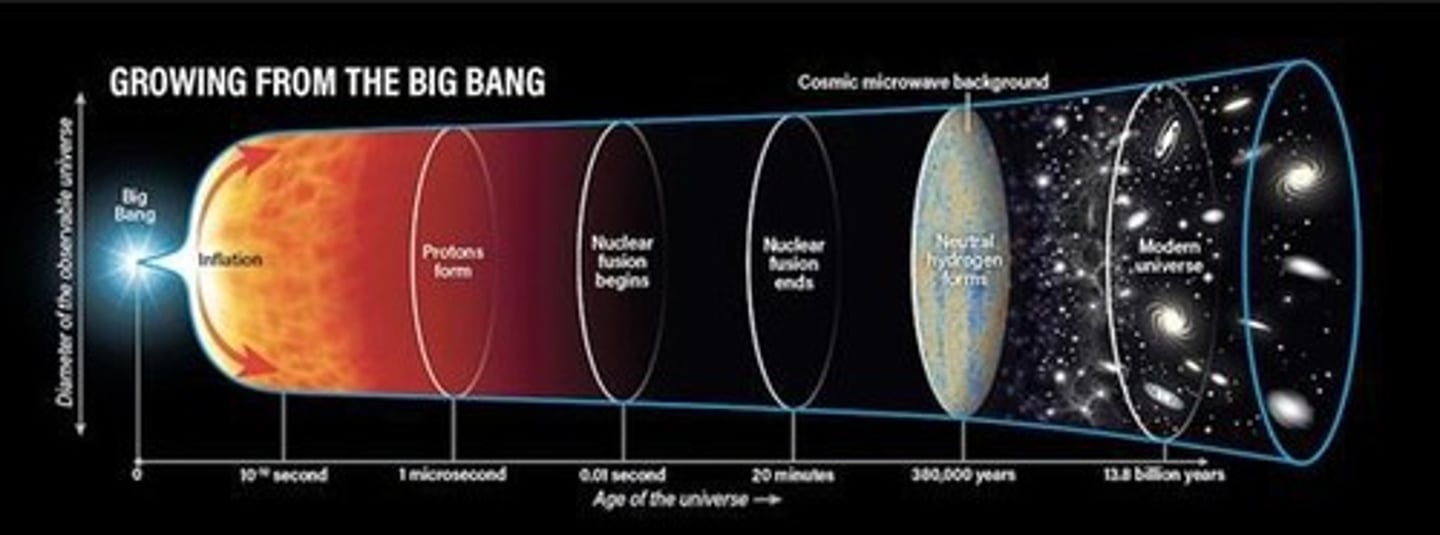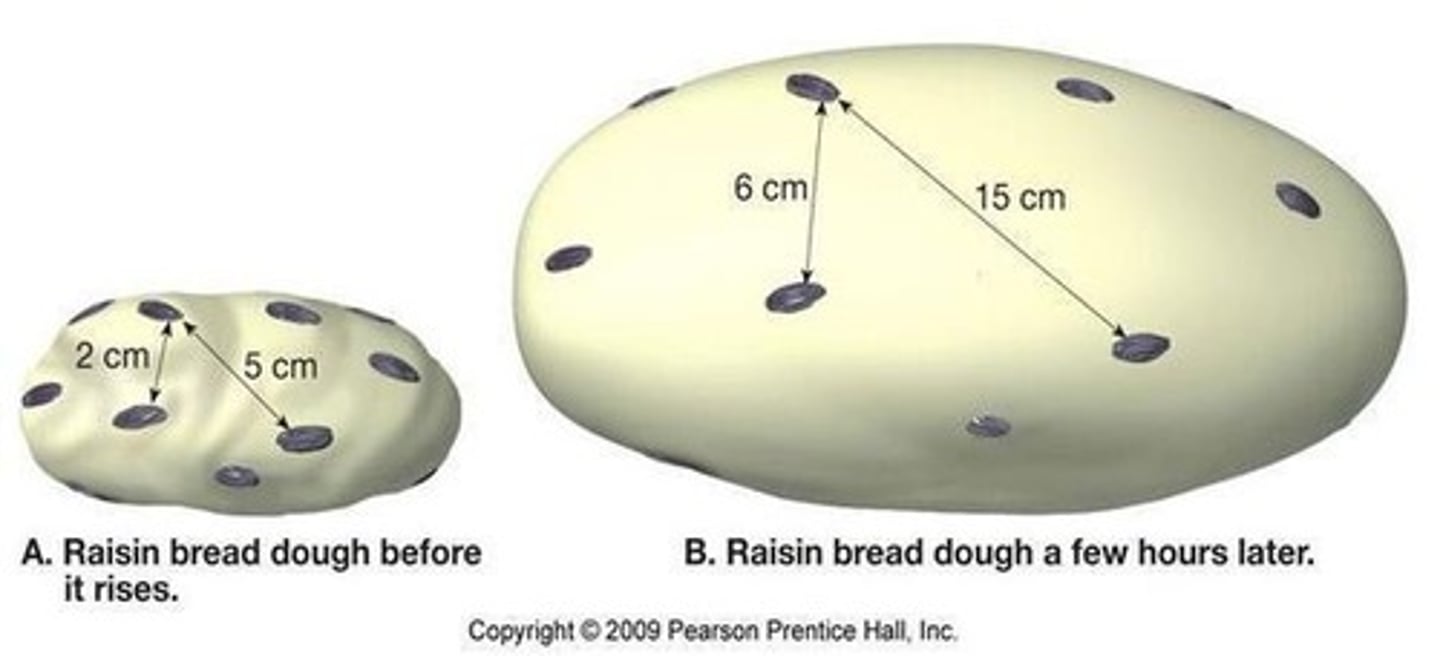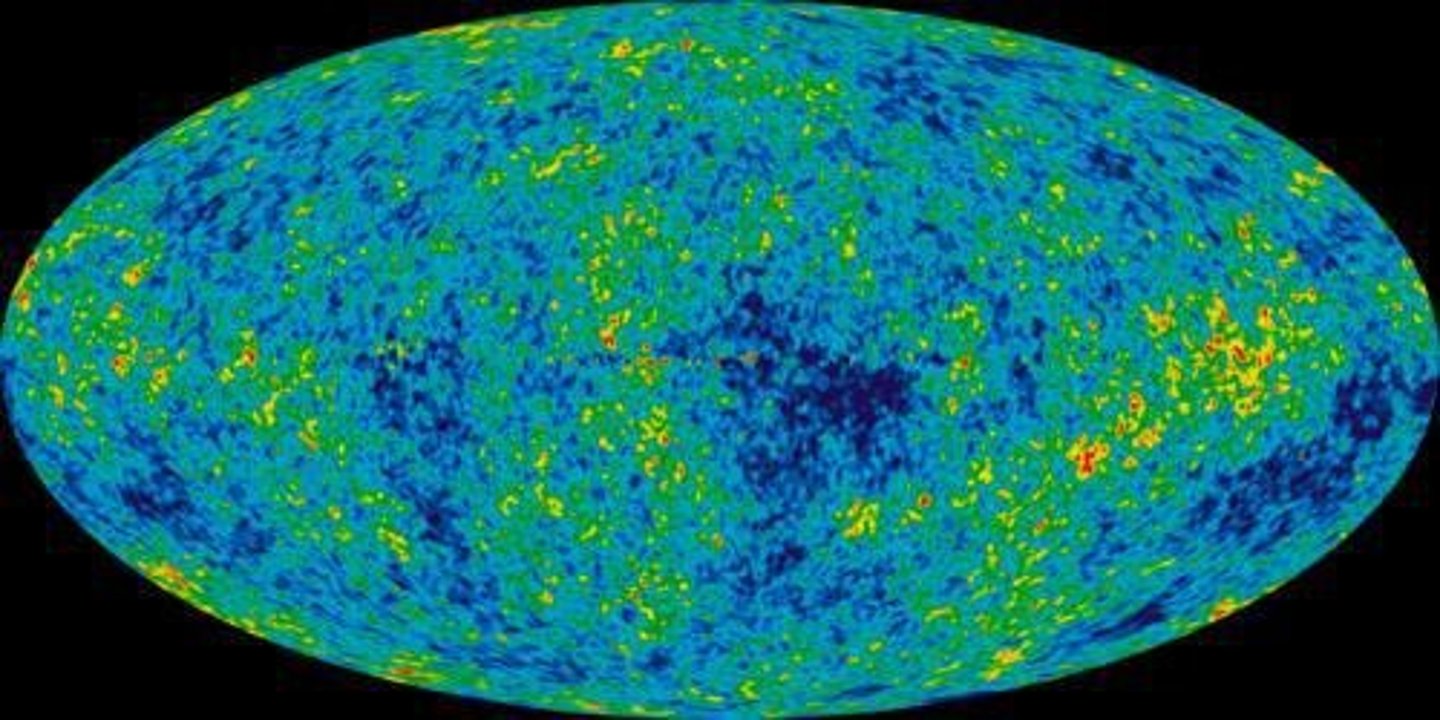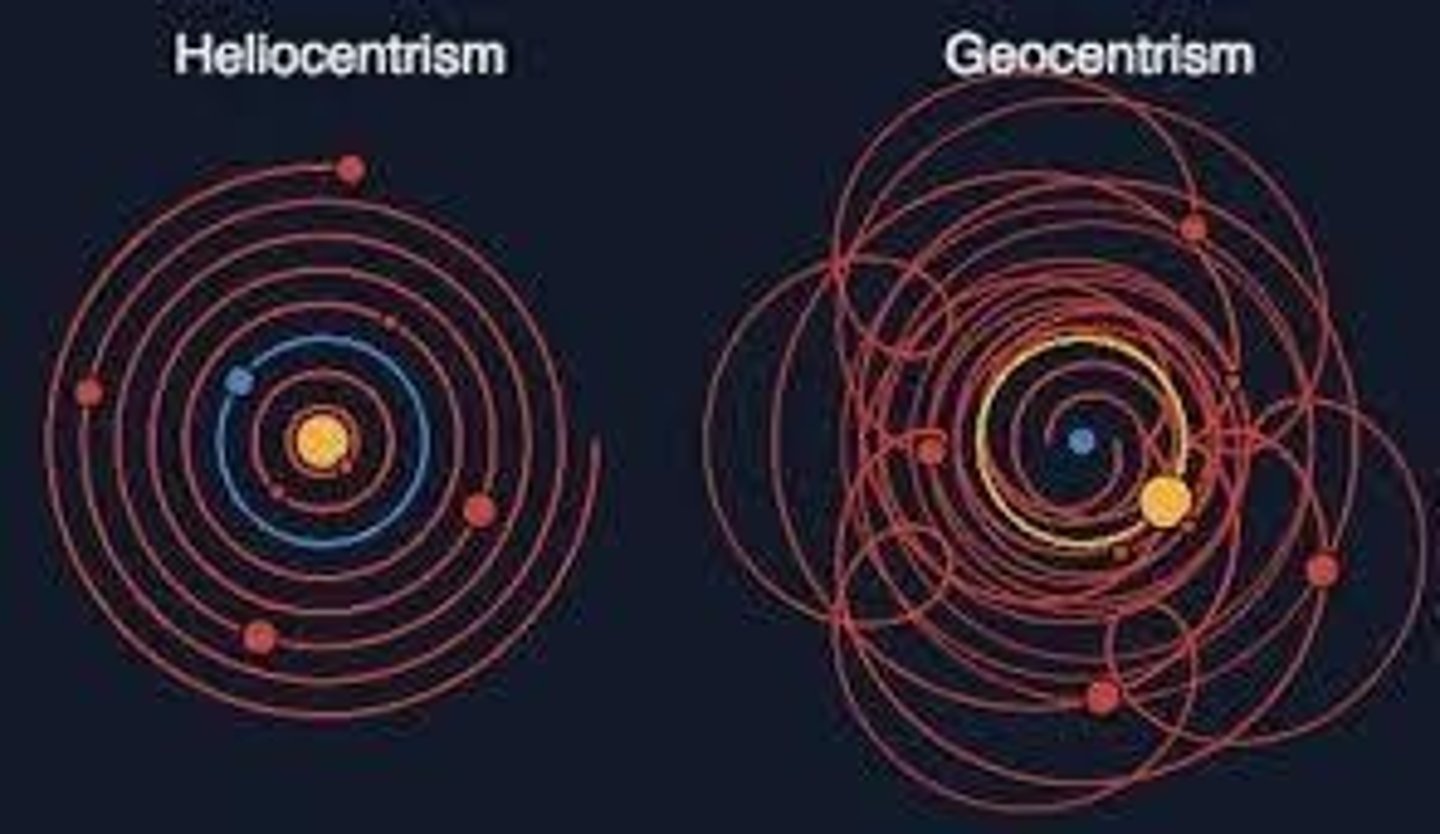Earth Science: Universe, Solar System, and Galaxy Fundamentals
1/75
There's no tags or description
Looks like no tags are added yet.
Name | Mastery | Learn | Test | Matching | Spaced |
|---|
No study sessions yet.
76 Terms
Big Bang Theory
The theory that the universe started as a single point and began to expand and cool approximately 13.7 billion years ago.
Cosmological Red Shift
The phenomenon where galaxies exhibit motion, specifically that most galaxies have spectral shifts toward the red of the spectrum, indicating they are moving away from us.
Nebular Clouds
Enormous clouds of gas in space that are part of the composition of the universe.
Georges Lemaître
The proponent of the Big Bang Theory who proposed that the universe began from a concentrated region smaller than a coin.

Hubble Space Telescope
A space telescope that has provided evidence for the expanding universe through observations of galaxy clusters.
Schematic Diagram
A visual representation showing the sequential events on how the universe was created.
Milky Way Galaxy
The galaxy that contains our solar system, composed of millions of stars and planets.
Interstellar Matter
The matter that exists in the space between stars, including gas and dust.
Solar System
The collection of planets and other celestial bodies that orbit our sun.
Moons
Natural satellites that orbit planets in the solar system.
Life Cycle of Stars
The series of stages that a star goes through from formation to death.
Origin of the Universe
The beginning of the universe, often explained by the Big Bang Theory.
Origin of the Solar System
The formation of the solar system from the gravitational collapse of a giant molecular cloud.
Characteristics of Planets
The distinct features that differentiate the planets in the solar system, such as size, composition, and atmosphere.
Vesto Slipher
The astronomer who first observed that galaxies exhibit motion in 1912.
Edwin Hubble
The astronomer who expanded on Slipher's work in 1929 and provided evidence for the expanding universe.
Evidence for an Expanding Universe
Observations and data supporting the idea that the universe is continuously expanding.
Composition of the Universe
The various elements and materials that make up the universe, including stars, planets, and interstellar matter.
Hubble's Law
The law stating that galaxies recede at speeds proportional to their distances from the observer.
Raisin Dough Analogy
An analogy illustrating Hubble's law, where raisins represent galaxies and dough represents space, expanding as the dough rises.

Cosmic Microwave Background (CMB)
The thermal leftover radiation from the early universe, discovered by Robert Wilson and Arno Penzias, providing evidence against the steady state theory.

Components of Spiral Galaxies
Spiral galaxies consist of three main parts: the bulge, the disk, and the halo.
Nebulae
Large clouds of interstellar matter that serve as nurseries for star formation.
Abundances of Light Elements
The actual amounts of hydrogen and helium observed in the oldest stars and gas clouds, supporting the big bang theory.
Gravity's Role in Universe Expansion
As the universe expanded, gravity caused matter to accumulate into large clumps and strands.
Elliptical Galaxies
Galaxies that have an oval shape and lack the distinct structure of spiral galaxies.
Irregular Galaxies
Galaxies that do not have a definitive shape or symmetry.
Thermal Radiation
Radiation that is a remnant from the early universe's cooling phase, leading to the formation of atoms.
Nobel Prize in Physics 1978
Awarded to Robert Wilson and Arno Penzias for their discovery of the Cosmic Microwave Background.
Steady State Theory
The theory that posits the universe is constant and uniform, contradicted by evidence from the CMB.
Diameter of Milky Way
The Milky Way galaxy has a diameter of about 100,000 light years.
Stars in Milky Way
The Milky Way is estimated to contain approximately 100 billion stars.
Observable Universe
The portion of the universe that can be observed from Earth, which includes the Milky Way.
Expansion of the Universe
The phenomenon where galaxies are moving away from each other, leading to an increase in the distance between them.
Clumps of Matter
Large accumulations of interstellar matter formed as the universe expanded.
Oldest Stars
Stars that provide evidence for the abundances of light elements consistent with big bang predictions.
Bright Nebulae
Nebulae that grow when in close proximity to very hot (blue) stars.
Dark Nebulae
Clouds of interstellar material that are too far from bright stars to be illuminated.
Terrestrial Planets
The solid and rocky planets closest to the sun, which include Mercury, Venus, Earth, and Mars.
Gas Giants
The larger planets in the solar system, specifically Jupiter and Saturn, known for their large ring systems.
Ice Giants
The planets Uranus and Neptune, located farther out in the solar system.
Kuiper Belt
An enormous stretch of space beyond the ice giants that contains a host of smaller icy worlds.
Dwarf Planet
A classification for Pluto and three other Kuiper Belt objects, as well as Ceres in the asteroid belt.
Geocentric Model
The ancient theory that the Earth is at the center of the universe, with all celestial bodies rotating around it.
Heliocentric Model
The concept that the sun is at the center of the universe, which first emerged in Ancient Greece.

Mass of Nebulae
The total mass of a nebula can be many times that of the Sun.
Formation of Solar System
Believed to have formed about 4.5 billion years ago from the collapse of a massive interstellar cloud of gas and dust.
Asteroid Belt
A region of space rocks left over from the formation of the planets, located after the orbit of Mars.
Jovian Planets
A term used to refer to the gas giants Jupiter and Saturn.
Pluto
Once considered the ninth planet, now classified as a dwarf planet.
Interstellar Dust
Composed of atoms, molecules, and larger dust grains of heavier elements found within interstellar matter.
Diffuse Matter
Matter that is extremely spread out, similar to fog, with no distinct edges or boundaries.
Aristarchus of Samos
Greek philosopher who proposed the heliocentric theory in the 3rd century BC.
Copernican theory
The theory that the Sun is at the center of the cosmos and celestial bodies move around it.
Celestial bodies motion
The motion of celestial bodies is uniform, eternal, and circular or compounded of several circles.
Earth's motions
The Earth has three motions: daily rotation, annual revolution, and annual tilting off its axis.
Retrograde motion
The backward motion of the planets explained by the Earth's motion.
Distance from Earth to Sun
The distance from the Earth to the Sun is small compared to the distance to the stars.
Moons in the solar system
Approximately 150 moons orbit planets in our solar system, with varying numbers for each planet.
Natural satellites
Moons are more common in the outer reaches of the solar system.
Mars' moons
Mars has two small moons called Phobos and Deimos.
Earth's moon
Earth has just one moon.
Jupiter's moons
Jupiter has 79 moons.
Saturn's moons
Saturn has 62 moons.
Uranus' moons
Uranus has 27 moons.
Neptune's moons
Neptune has 14 moons.
Pluto's moons
Pluto has five moons, one of which is Charon, forming a binary system.
Earth's atmosphere
Earth's atmosphere is composed mainly of nitrogen and oxygen, key for sustaining life.
Venus and Mars' atmosphere
The atmospheres of Venus and Mars are mostly carbon dioxide.
Gas giants' atmosphere
The thick atmospheres of Jupiter, Saturn, Uranus, and Neptune are made primarily of hydrogen and helium.
Mercury's atmosphere
Mercury does not have an atmosphere; it has an exosphere made of oxygen, hydrogen, sodium, helium, and potassium.
Living planet
Earth is the only planet in the solar system known to harbor life.
Magnetic field
Earth has a molten nickel-iron core which gives rise to an extensive magnetic field.
Universe
The Universe is made up of millions of stars and planets and enormous clouds of gas separated by a gigantic space.
Galaxy
A galaxy is a large group of stars, gas, and dust bound together by gravity.
Terrestrial and Jovian Planets
The Solar System is composed of Terrestrial and Jovian Planets.